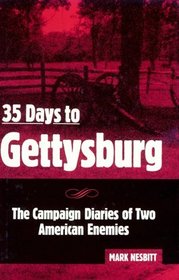The author uses real dairies of two Civil War soldiers---one Confederate and one Union, both in their early to mid-twenties--- to trace their movement and thoughts from early June, 1863, to just after the Battle of Gettysburg in July, 1863. Frequent full-page maps track their progress.
One left the battle alive, while the other didn't.
The author also adds commentary to their diary entries and what is happening in the greater picture of the two armies in their movement to their clash in the greatest battle ever fought in North America.
There are two small problems which don't detract from the narrative. The author has a Union officer discovering Robert E. Lee's plans wrapped around cigars just before the Battle of Antietam in September 1862. Actually, it was two Union enlisted men who discovered the plans. And the author states not many casualties resulted from the use of bayonets. As causalities were recorded at hospitals, this overlooks the number who died from bayonet wounds. As the bayonet was a triangular blade, a wound received from it didn't close. So, unless the bayoneted man received prompt medical assistance, he quickly bled to death and never made it to a hospital.
One left the battle alive, while the other didn't.
The author also adds commentary to their diary entries and what is happening in the greater picture of the two armies in their movement to their clash in the greatest battle ever fought in North America.
There are two small problems which don't detract from the narrative. The author has a Union officer discovering Robert E. Lee's plans wrapped around cigars just before the Battle of Antietam in September 1862. Actually, it was two Union enlisted men who discovered the plans. And the author states not many casualties resulted from the use of bayonets. As causalities were recorded at hospitals, this overlooks the number who died from bayonet wounds. As the bayonet was a triangular blade, a wound received from it didn't close. So, unless the bayoneted man received prompt medical assistance, he quickly bled to death and never made it to a hospital.





